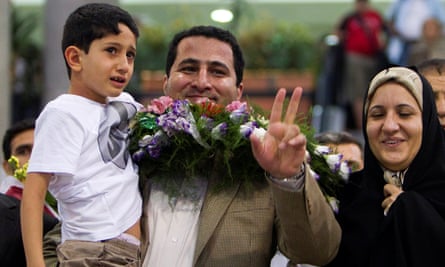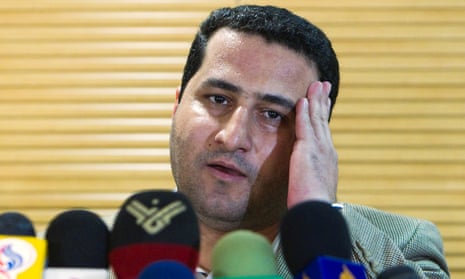An Iranian nuclear scientist, whose disappearance in Saudi Arabia in 2009 and subsequent return to Tehran a year later from Washington was shrouded in mystery, has been executed in his home country.
The family of Shahram Amiri, an expert in radioactive isotopes at Tehran’s Malek Ashtar University, which is affiliated to Iran’s ministry of defence, told two overseas Persian-language TV networks at the weekend that he had been executed earlier in the week at an unknown location.
The spokesman for the Iranian judiciary confirmed on Sunday that Amiri had been hanged, claiming he had given away state secrets. The semi-official Tasnim news agency quoted Gholam-Hossein Mohseni-Eje’i as saying that Amiri had been convicted of spying and put to death after his sentence was upheld by the supreme court.
“This person had obtained top secret information and established contacts with our number one sworn enemy, America, and passed on our country’s most crucial intelligence to the enemy,” Mohseni-Eje’i said.
Amiri’s execution marks the final dark chapter in a real-life spy drama that was the subject of much speculation. It also gives more weight to claims that he defected to the US after going missing on a pilgrimage to Mecca some time in spring 2009.
A few months after Amiri’s disappearance, Iran’s then foreign minister Manouchehr Mottaki accused the US of abducting the scientist. But ABC News reported in March 2010 that he had defected to the US as part of an intelligence coup aimed at undermining Iran’s nuclear programme. That report said he had been extensively debriefed by the US authorities.

While in the US, Amiri appeared in a string of online videos that added to the mystery surrounding his case. In the first video, released by Iranian state TV, the scientist said he had been kidnapped in Medina, Saudi Arabia, in a joint operation by the CIA and Saudi intelligence and was being held captive in the US.
In the second video, released on YouTube, Amiri said he had decided to continue his studies in the US. In the third video, broadcast again by Iranian state TV, Amiri claimed to be on the run from the CIA. He then presented himself to the Iranian interest section at the Pakistani embassy in Washington, asking to go home.
He received a hero’s welcome in Tehran and was portrayed as someone who had fled American captivity. The Iranian media extensively covered his return and a deputy foreign minister greeted him at the airport.
What happened next is unknown until opposition websites reported that he had been imprisoned and tortured in jail.
Before his return to Iran, the then US secretary of state Hillary Clinton had said “Mr Amiri has been in the United States of his own free will” and that “he’s free to go, he was free to come, these decisions are his alone to make”.
In mid-July 2010, as Amiri returned to Tehran, the Washington Post reported that he was allegedly paid $5m by the CIA for the intelligence he had shared on Iran’s nuclear activities. Reports of Amiri’s imprisonment intensified speculation that he was forced to return by threats to his relatives, but the exact sequence of events that led to this remain unclear. In 2012, it was reported that he had been sentenced to 10 years in jail but Mohseni-Eje’i said on Sunday those reports were untrue and he had been sentenced to death from the beginning.
Mark Fitzpatrick, the director of the non-proliferation and disarmament programme at the International Institute for Strategic Studies (IISS), told the Guardian: “When Amiri decided to return to Iran, he should have realised he would be in for a rough time. I did not expect it would get this rough, however.”
Fitzpatrick, referring to the assassination of four Iranian nuclear scientists between 2010 and 2012, added: “It’s ironic that, while a foreign country, assumed to be Israel, stopped killing Iranian nuclear scientists four years ago, the Islamic Republic of Iran has now done it to itself.”
The release of Clinton’s emails last year by the State Department appeared to have been damning for Amiri. A number of emails sent to the then secretary of state appeared to support claims that he was a defector. “Our friend has to be given a way out. We should recognise his concerns and frame it in terms of a misunderstanding with no malevolent intent and that we will make sure there is no recurrence. Our person won’t be able to do anything anyway. If he has to leave, so be it,” wrote one senior official to Clinton, according to CNN.
“Following the reported revelations in the Clinton emails, Amiri was executed for spying,” said Dina Esfandiary, MacArthur fellow at the centre for science and security studies at King’s College London. “In the Iranian judiciary’s mind, it’s a necessary signal to the US that Iran is aware of their activities in Iran and that this is what is done to those who help the enemy. It’s a textbook spying case.”
Iranian hardliners, who dominate the judiciary and the intelligence apparatus, have vociferously opposed the nuclear deal that Hassan Rouhani, the president, struck with the west last year. According to Esfandiary, Amiri’s execution could also play internally as Rouhani enters his final year in office. “It’s also another shot at the Rouhani camp amid intense political infighting a year after the Iran deal and months before the elections,” she tsaid.
Amiri’s case unfolded during a covert campaign to stop Iran from advancing its nuclear activities by using cyber attacks, most notably the Stuxnet computer worm, and murdering its nuclear scientists. Five assassination attempts between 2010 and 2012 resulted in the killing of four scientists and experts and the injuring of another scientist who was later promoted as the country’s nuclear chief. Iranian officials accused the west, the US and Israel of being behind both campaigns.
That covert campaign appears to have cooled following last year’s landmark nuclear deal. Ali Vaez, the senior Iran analyst at the International Crisis Group, said Amiri’s execution had given rise to more questions than answers and that “the judiciary’s lack of transparency on a dossier of national importance is regrettable”.
“Be it for his own mistakes or for falling prey to dark arts of western intelligence, Amiri was a victim of the nuclear standoff and its viciousness,” he said.










